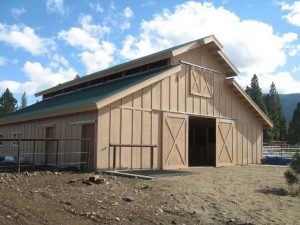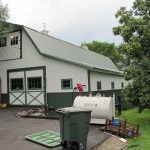Welcome to Ask the Pole Barn Guru – where you can ask questions about building topics, with answers posted on Mondays. With many questions to answer, please be patient to watch for yours to come up on a future Monday segment. If you want a quick answer, please be sure to answer with a “reply-able” email address.
Email all questions to: PoleBarnGuru@HansenPoleBuildings.com
DEAR POLE BARN GURU: Hi,
I recently built myself a pole-barn home in NY that used the traditional flat girt style with columns 8′ OC and a double 2×10 truss header and trusses 4’OC.
The overall result has been great as we have achieved net-zero energy with our all electric utilities and solar PV array.
I’m thinking of getting into the home building business and want to use the post-frame technology to deliver the most affordable and highly-engineered product.
After reading your site, I’m totally sold on the double truss system and 12′ OC truss spacing. However, using flat girts on either side of the posts gives us an extra 3″ of insulation and also reduces thermal bridging in the assembly for the spaces between the posts (essential for getting the heat loss down for the building).
Is there any way to combine the two methods? For example, i was thinking of using intermittent single studs between the columns that are anchored to the floor to support the flat girts in between the posts.
Or are there any creative solutions that you have used in the past or can think of? Here are a few photos of my project for reference. If you have any questions feel free to contact me.
Thanks, KNOWING IN NEW YORK
DEAR KNOWING: Thank you for visiting our website, we hope you will continue to avail yourself of the free information available within it.
Post frame (pole building) construction will certainly be more affordable than any other permanent type of construction, and it does afford the ability to create some deep insulation cavities.
The challenge of flat girts on the outside of the columns is they (in most cases) will deflect more than what is allowed by the Codes. Read more about flat wall girt deflection here: https://www.hansenpolebuildings.com/blog/2012/03/girts/
Here is an idea which might meet with all of your needs…..between the wall columns, install either bookshelf style girts (https://www.hansenpolebuildings.com/blog/2011/09/commercial-girts-what-are-they/) or construct a vertical stud wall with the thickness of the wall matched to the size of the wall columns. With bookshelf style girts, make the girts the next size larger than the columns, and leave 1-1/2″ sticking outside of the column faces. In the stud wall scenario, place 2×4 “flat” girts on the face of the studs, across the columns, at 24 inches on center. Regardless of the route, use a high quality building wrap to cover the girts prior to application of either sheathing or siding.
I’d recommend the use of BIBs insulation: https://www.hansenpolebuildings.com/blog/2011/11/bibs/
On the inside – Use reflective insulation with adhesive pull strips as your vapor barrier, then apply drywall.
Good Luck and let me know how you come out – I appreciate the photos!
Mike the Pole Barn Guru
DEAR POLE BARN GURU: Greetings, are the “typical” roofs -as in your monitor style project 04-0328, considered “walkable” for once in a while fixes? Not planning on making it a habit –just good to know ADVENTURING IN ARIZONA
DEAR ADVENTURING: I’ve been asked this question more than a few times over the years, and have always wondered why it is anyone would actually want or need to be walking around on their roof. With steel roofing, unless it is installed improperly in the beginning, there should never be a “fix” to be made.
Shingled roofs are an entirely different story – as shingles are very susceptible to damage, especially from hail. For more reading on hail damage:
https://www.hansenpolebuildings.com/blog/2013/05/steel-roofing-5/
The answer to your posed question is – yes, the roofs can be walked on. Because steel roofing can be slippery, if you feel the desire to walk on the roof, please use care to step only where there is a screw – the head of the screw will give a traction point to help you stay on the roof. And be sure to use shoes with good soles on them.
Mike the Pole Barn Guru
DEAR POLE BARN GURU: Scissor trusses, or raised lower cord and false economy?
Some claim that the increased cost of the truss is offset by the reduction in side wall height. CHAFING IN CHAFFEE
DEAR CHAFING: For just a moment let’s assume the scissor trusses add no extra cost. A tall door is placed in the center of an endwall (after all – the concept of scissor trusses is most often to be able to get a taller door, into an eave height the door should not fit in). The door is opened and the VTT (very tall thing) is driven into the building. The then driver decides the VTT would be ideally parked off to one side, rather than right in the center of the building, where it cannot be easily gotten around.
A loud WHAP is heard, right before the roof caves in on top of the VTT, because the VTT has run into the bottom chord of the scissor trusses – which are lower closer to the sidewalls of the building.
In nearly every case I can imagine, it will be less expensive to have a taller sidewall and complete unobstructed use of the inside of the building, than to go with scissor trusses.
There are some cases where scissor trusses make sense – and none of them have anything to do with economy.
Planning upon finishing the ceiling and like the look of a vaulted ceiling? Scissor trusses make sense.
Your Planning Department has a restriction upon eave height (but not overall height) – scissor trusses again make sense.
The verdict – false economy.
Mike the Pole Barn Guru
DEAR POLE BARN GURU: Per square foot cost of steel pole with 6″ concrete floor and pitch roof with 14′ door. BONKERS IN BAY CITY
DEAR BONKERS: As the boss used to say, $3 a square foot, but you need to cover at least an acre. Have an 8’ eave with no walls, lots of interior columns and an uninsulated galvanized roof.
Pole buildings, just like any other form of construction, become more cost effective as the “footprint” of the building increases. Want to lower the cost per square foot? Enclose more square feet. Or reduce the eave height. Or go narrower and longer rather than wide but shorter. Or don’t put on any doors. Or take off the overhangs, wainscot or other features. Or….get the picture?
The quickest and best way to get an exact price on any pole building is to put in a request for a quote at: https://www.hansenpolebuildings.com/freequote.htm
And if you get a quote, don’t compare a 40’ wide by 24’ deep to someone else’s 60 x 80 by only using “per square feet” as your measure. Get a comparison of “apples to apples” – that’s the only way you will know exactly what you are paying for.
Mike the Pole Barn Guru









